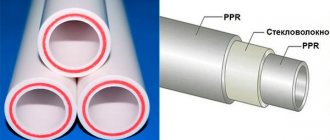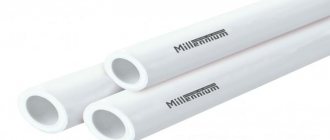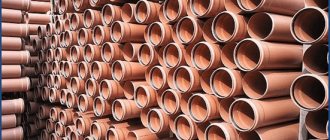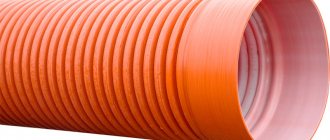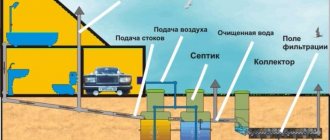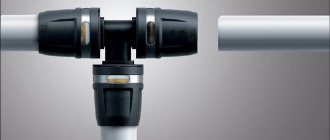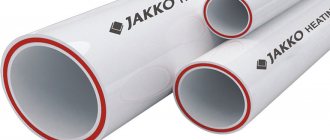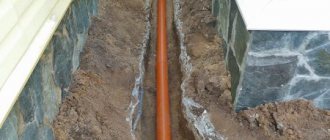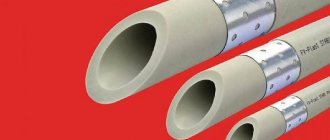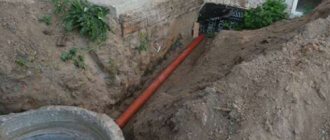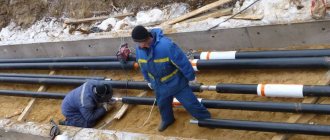Today, polymer pipes are used in various fields. Polypropylene sewer pipes are very popular. Such products are distinguished by their versatility and high inertia, so they are ideal for any drainage structures. In addition, a wide range of such parts allows you to select suitable elements for different communications.
Polypropylene sewer pipes are suitable for all types of drainage systems
What are polypropylene pipes
Polypropylene pipes for sewerage are considered to be the most successful choice of material both in terms of performance and price. Plastic has special properties - being the least dense among all types of plastics, polypropylene is harder than polyethylene. It does not tolerate ultraviolet radiation and contact with atmospheric oxygen, which is compensated for in manufacturing using stabilizing additives. Polypropylene pipes are the cheapest of all alternative options, but in terms of operational and technical characteristics they are superior to analogues made from other materials. The sewage system assembled from them lasts a very long time and does not require any maintenance. It is resistant to all influences, aggressive chemical compounds, and temperature changes.
Polypropylene pipes for sewerage, the technical characteristics of which are optimally suited for use on both the internal and external parts of the system. They are fully compatible with pipelines and fittings made from other materials. The only limitation that must be applied to PP products for outdoor use is compliance with the requirements for immersion depth (at least 0.7 m). This is important, since they are quite soft and can be deformed by soil pressure, passing cars or people moving around.
There are several types of PP sewerage. Most types are intended for use in water supply systems, in particular, PPR varieties made from type 3 polypropylene. They are able to withstand operating water pressure and other operating loads. Sewage networks are predominantly free-flow, so they most often use units made of PP polypropylene. They are cheaper, but have less resistance to stress.
Properties of polypropylene
Plastic, which is gradually replacing cast iron and steel, is already ubiquitous. If this material is not suitable for heating systems, then when constructing sewer drains, choosing it is beneficial from an economic point of view.
Polypropylene replaced polyvinyl chloride. Due to the positive properties of the material, PP products can be used in various conditions:
- The polymer has a density of 900 kg/cu m. It is lighter than cast iron, and installation of the pipeline does not take much time.
- Due to the high viscosity of the material (the ability to absorb impact energy), it is able to withstand significant mechanical loads.
- Gutters made of polypropylene can be operated from -15 to +140 degrees.
- Due to the chemical inertness of the material, according to GOST, wastewater containing 60% sulfuric acid is allowed to be discharged through pipes.
- When heated, the polymer becomes plastic, so sections with a diameter of 16-1200 mm can be made from it.
- The parameters of raw materials for pipe production are determined by GOST 26996-86. Various types of pipelines are made from this material. Non-pressure models are used for sewer installation.
Such properties of polypropylene products make it possible to choose them for the installation of durable sewage systems.
Advantages and disadvantages of PP pipes
Sewage pipes made of polypropylene have the following advantages:
- long service life. According to manufacturers, they do not lose their working qualities for up to 50 years, and if only cold water is supplied - up to 100 years;
- not prone to the formation of layers or solid deposits;
- do not spread noise;
- polypropylene has low thermal conductivity, so there is no condensation on the surface of the pipes;
- sewerage made from polypropylene pipes is 9 times lighter than the same system made from metal pipelines;
- ease of installation work;
- do not require care or special maintenance;
- do not react to exposure to water or aggressive chemical compounds;
- have high elasticity and resist mechanical stress well;
- The cost of PP pipes is low and available to the mass buyer.
The disadvantages of the material include:
- have a high coefficient of linear expansion with temperature changes;
- difficulty in bending pipes. Despite its elasticity, the material has high memory and always returns to its original shape. The only option for bending is fixation using external mandrels or pouring concrete;
- when the temperature drops, they become brittle, so the systems are used for external areas with certain restrictions.
Of all similar products, it is polypropylene sewer pipes that demonstrate the optimal set of performance qualities combined with a low price.
You may also like: Mole for drain cleaning - how the product works!
What raw materials are they made from?
All pipes from the original group are called polypropylene. The composition of raw materials may differ for different samples. For example, mineral or organic substances are added to the original polymer. This allows you to specify specific sets of properties.
The composition of raw materials is an important factor for those who want to choose the best option for polypropylene pipes. The most information can be obtained from the labeling. PPR80 is considered the most optimal solution.
Types of sewer PP pipes
GOST for polypropylene sewer pipes requires manufacturers to provide certain properties for each type of product. The marking consists of an alphanumeric code. The first two letters PN are accompanied by numbers indicating the maximum permissible pressure in kg/cm2:
- PN10. The most common pipes are the conventional type. Used for assembling internal sewerage; with some restrictions, they can be used for underfloor heating or cold water supply systems;
- PN16. Designed for use in non-pressure sewer systems;
- PN20. They have increased impact strength. Used in pressure sewer systems, special-purpose ventilation networks;
- PN25. Reinforced pipelines with a low coefficient of thermal expansion and high strength. This was achieved by adding additional layers of aluminum foil, fiberglass and other materials. Used for external sewerage areas, as well as in pressure systems.
Reinforcement has solved a lot of problems with ultraviolet radiation or exposure to oxygen. Strength has increased, and it has become possible to withstand the chemical and mechanical effects of groundwater. This made it possible to expand the scope of application, increase demand and preference among users.
Variety of sizes
Such a characteristic as wall thickness is an equally important indicator. After all, the internal diameter of the pipes directly depends on this parameter. The table below shows the variety of sizes of polypropylene pipes produced by modern industry.
| Outer diameter, mm | Wall thickness PN25 with aluminum. foil, millimeters | Wall thickness PN20, millimeters | Wall thickness PN16, millimeters | Wall thickness PN10, millimeters |
| 16 | 2,7 | 2,7 | ˗˗˗ | ˗˗˗ |
| 20 | 3,4 | 3,4 | 2,8 | 1,9 |
| 25 | 4,2 | 4,2 | 3,5 | 2,3 |
| 32 | 5,4 | 5,4 | 4,4 | 3,0 |
| 40 | 6,7 | 6,7 | 5,5 | 3,7 |
| 50 | 8,4 | 8,4 | 6,9 | 4,6 |
| 63 | 10,5 | 10,5 | 8,4 | 5,8 |
| 75 | 12,5 | 12,5 | 10,3 | 6,9 |
| 90 | 15,00 | 15,00 | 12,3 | 8,2 |
| 110 | 18,4 | 18,4 | 15,1 | 10,00 |
Application area
The main area of application of PP pipelines is sewerage systems for domestic and industrial purposes. They are used in both pressure and non-pressure systems.
For gravity (non-pressure) networks, sewer socket pipes made of PP polypropylene grade PN16 are used. The estimated service life of such pipes is 200 years, although this cannot be verified in practice. They have a socket at one end that acts as a coupling. A rubber O-ring is installed inside, facilitating and speeding up the assembly process. Used in different parts of the system:
- sewer pipes made of polypropylene for internal sewerage. The main part of the system consists of pipes with a diameter of 50 mm, with the exception of the tee for the toilet bowl and the vertical riser, the size of which according to GOST is usually 110 mm;
- for external sewerage. A special type of pipe (red color) with reinforced double-layer walls is used. Some of them have a corrugated layer on the outside that can withstand mechanical stress.
The use of PP pipes in pressure systems is quite common, although this type of sewage system itself is rare. According to GOST requirements, PP pipes for sewerage must meet the requirements of the PN20 or PN25 standard, which fully corresponds to the specifics of the operation of pressure systems.
You may also like: Grease trap for dining room drainage: how it works, device, advantages!
Installation of PP pipelines
Installation of polypropylene pipelines is carried out in two ways:
- bell-shaped For connection, there is a special coupling at one end into which the free end of the other pipe is inserted. In turn, the next part is inserted into its coupling - and this way you can assemble a line of any length.
- welded Typically, this connection method is chosen if a pressure system is being installed. A specially designed welding machine is used to heat the joint area to the melting temperature of the material. As a result, a monolithic connection is formed, allowing the pipeline to be used in difficult conditions and under standard operating pressure.
The properties possessed by a polypropylene sewer pipe are defined by GOST and other regulatory documents as the most successful, efficient and cost-effective. Simplicity and high speed of installation make it possible to create sewerage systems in any residential or industrial premises operating in difficult conditions and withstanding heavy loads.
Features of installing external sewerage
For the installation of external sewerage, two-layer pipes are used, having a smooth inner surface and corrugated outside. The installation of such elements is carried out with a deviation in the range from 10 to 20 mm. When installing the pipe, the soil should be thoroughly compacted so that the pipe does not collapse under the influence of soil. Before installing the products, the bottom of the trench is covered with sand 20 cm high.
Pipes are laid in the ground, taking into account the characteristics of the soil, weather conditions and the load on the area where the pipeline will be laid. It is better to bury it at a depth of up to 0.8 m. In this case, the soil pressure should be low.
